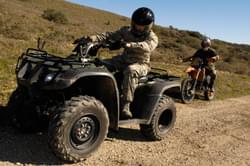Colorado State Parks Motorized Vehicle Trail Use Guidelines
From the Colorado Off-Highway Vehicle Program
Safety considerations and trail use guidelines for OHV recreation
by
Colorado Parks and Wildlife - OHV Program
Safety considerations
- Plan ahead. The weather can change rapidly.
- Carry all necessary supplies including an emergency repair kit, food, water and warm clothing.
- Develop a supply checklist to include the above items and other equipment such as area maps and guides, protective gear, flashlight, sunscreen, etc.
- Know what to wear. Quality helmets, gloves, boots, goggles and protective clothing will keep you comfortable and help prevent serious injuries.
- Know your vehicle. Keep it in good condition and read the owner's manual.
- Let someone know where you're going and when you expect to return.
- Travel with other people.
- Know before leaving what to do in an emergency.
Trail use guidelines
- Respect all private and public property and the rights of all recreationists to enjoy nature.
- Park considerately without blocking other vehicles or impeding access to trails.
- Keep to the right when meeting other recreationists and yield the right-of-way to downhill traffic.
- Slow down and use caution when approaching or overtaking another.
- Travel only where motorized vehicles are permitted.
- Respect designated areas, trail use signs and established ski tracks. Stay out of wilderness areas.
- Do not block the trail when stopping.
- Do not disturb wildlife. Avoid all areas posted for their protection or feeding.
- Do not litter. Pack out everything you pack in.
- Realize that your destination and travel speed are determined by your equipment, ability, terrain, weather and traffic on the trail. Plan accordingly.
- Do not interfere with or harass others. Recognize that people form opinions about all motorized vehicle users based on your actions.
1,506 views • posted 06/09/2018





